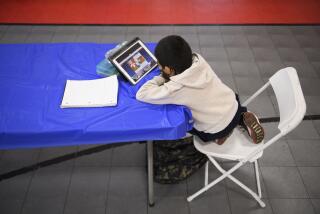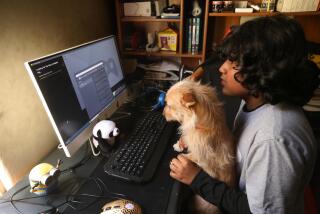Feds aid viewers’ move to digital
WASHINGTON — The federal government doesn’t usually give things away, but starting Tuesday broadcast TV watchers can apply for a gift that could keep their sets from going dark in 2009.
Via a toll-free hotline and a website, the Commerce Department will begin accepting applications for coupons worth $40 off a no-frills converter box to allow older televisions to receive digital broadcast signals.
“We are open for business Jan. 1,” said Bart Forbes, a spokesman for the National Telecommunications and Information Administration, the Commerce Department agency running the program.
The $1.5-billion program is designed to ease the major change coming on Feb. 17, 2009. That’s when broadcast TV stations turn off their analog signals and start transmitting only in digital.
The program -- the biggest change in broadcast TV since the advent of color -- will free up valuable airwaves for public safety agencies and new wireless phone and Internet services. It will also deliver clearer pictures and additional broadcast channels for people who don’t have pay-TV service.
But some TV sets might have trouble making the technological leap. Ones without a built-in digital tuner will no longer be able to receive over-the-air signals unless they get a special box to change the signals back to analog.
Those boxes are expected to be available starting in February at more than 14,000 government-certified retail outlets, including Best Buy, Circuit City, RadioShack, Sears, Target and Wal-Mart shops. They will cost $59.95 to $69.95.
Satellite and cable customers won’t need converter boxes for TVs they have hooked up to those systems. But there are as many as 26 million households in the United States that only receive over-the-air TV -- and millions more that may want the option for emergencies or power outages when cable and satellite transmissions are down.
That’s the reason Eric Matsuoka, 58, of Montebello plans to get a converter box coupon even though he has cable service.
“I’m going to apply definitely, for back-up,” he said. “You’re not thinking of just your immediate comfort zone, just watching television -- you’ve got to think in case something happens.”
The NTIA has contracted with IBM Corp. to run the program. They have set up a toll-free number, (888) DTV-2009, which, starting at 3 a.m. Pacific time on Tuesday, will be staffed by live operators who can take requests in English, Spanish, Vietnamese and four other languages. Applications also can be filled out online at www.dtv2009.gov.
Each household is eligible for two coupons, regardless of whether it has cable or satellite service. After the first $890 million worth of coupons are distributed, the federal government will allocate an additional $450 million in coupons, but only to households that rely on over-the-air signals. The rest of the program’s $1.5-billion price tag is for administrative costs.
Although there is enough money for 33.5 million coupons, the National Assn. of Broadcasters has estimated there are as many as 70 million TVs hooked up to antennas, including extra sets in homes with cable or satellite. Many of those sets can receive only analog signals, although sales of high-definition TVs, which include digital tuners, have soared in the last two years.
The federal law that mandated the digital conversion required NTIA to start offering coupons Jan. 1. But officials are urging people to wait before applying. The coupons will expire 90 days after they are issued to assure they don’t go unused.
“We want to make sure that folks have the time to go in and redeem the coupon during that time period,” Forbes said. He urged people to check their local stores and see what boxes are available before applying.
The agency has certified 11 brands of converter boxes from eight manufacturers, including Zenith and Magnavox, as eligible for the program. To keep the cost down, the government is certifying only boxes with limited capabilities, not with other functions such as digital video recording or playing DVDs. The NTIA won’t mail out the coupons until the boxes are in stores, Forbes said.
The NTIA is planning to start a public awareness campaign in mid-February, one year before the broadcasters switch off their signals and around the time some of the converter boxes will be available.
The National Assn. of Broadcasters, which has been running ads as part of a $698-million public education campaign, will launch new ones in February touting the coupon program, said Shermaze Ingram, a spokeswoman for the group. “We’re integrating the converter box coupon program into everything we’re doing,” she said.
The coupon program is a major part of the government’s transition to digital television. But many members of Congress have criticized the way the Bush administration has handled it.
The Government Accountability Office said in November that there was “no comprehensive plan or strategy to measure progress and results” of the transition. A poll this fall by the Assn. of Public Television Stations found that although public awareness of the digital TV transition was improving, 51% still had no idea it was happening.
Matsuoka said many of his friends had no clue. “Television is part of your daily life, but there’s no information coming forth, and it’s really sad,” he said.
The federal government plans to ramp up its efforts this year. NTIA has only $5 million for public awareness, so it has been working with other government agencies, such as the Department of Veterans Affairs, as well as advocacy and community organizations, to spread the word. Among them is AARP, which is concerned that the elderly will have trouble dealing with the transition.
“Their budgets are tighter, [and] at the same time they watch more TV than any other demographic group and arguably are more dependent on it,” AARP spokesman Jim Dau said. “You put all those things together, it’s a very big issue.”
More to Read
From the Oscars to the Emmys.
Get the Envelope newsletter for exclusive awards season coverage, behind-the-scenes stories from the Envelope podcast and columnist Glenn Whipp’s must-read analysis.
You may occasionally receive promotional content from the Los Angeles Times.











